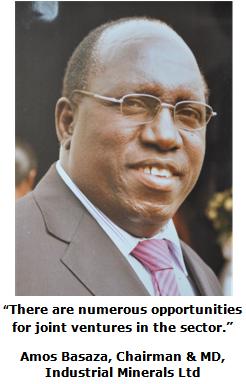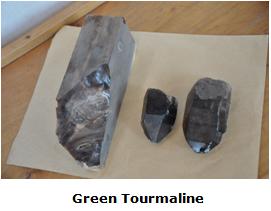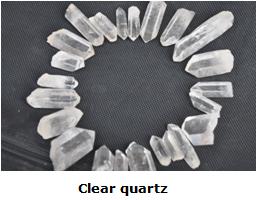 ReConnect Africa is a unique website and online magazine for the African professional in the Diaspora. Packed with
essential information about careers, business and jobs, ReConnect Africa keeps you connected to the best of Africa.
ReConnect Africa is a unique website and online magazine for the African professional in the Diaspora. Packed with
essential information about careers, business and jobs, ReConnect Africa keeps you connected to the best of Africa.



 Amos Basaza on how investors and Africans abroad can tap into Uganda's abundant mineral resources
Amos Basaza on how investors and Africans abroad can tap into Uganda's abundant mineral resources
Following the completion of airborne geophysical surveys over nearly 80% of Uganda, the Ministry of Energy and Mineral Development, through the Sustainable Management of Mineral Resources Project/Management of Mineral Resources and Capacity Building Project, is reaching out to all stakeholders and in particular to exploration/mining companies to make them aware of the availability of the survey results.
ReConnect Africa spoke to Amos G. Basaza, Chairman and Managing Director of Industrial Minerals Limited, about the opportunities in Uganda’s mineral and mining sector. Amos Basaza has extensive experience in Uganda’s mineral sector. An alumnus of Colorado School of Minerals in the United States, he has over 20 years experience in Uganda’s mining sector, 10 years of which was spent as the head of Kilembe Mines, Uganda's premier copper mines.
ReConnect Africa (RCA): Can you outline your own experience and how, in your opinion, the minerals and mining sector has undergone a transformation in Uganda?
Amos Basaza: I am a graduate of Makerere University Kampala, where I acquired my first degree in Geology and Chemistry, and later I obtained an Msc. from Colorado School of Minerals. The first practical experience I gained in the mineral sector was through working as a geology trainee before I was sponsored for further studies. I rose through the ranks right to the summit of the firm, gaining valuable experience along the way.
Mining in Uganda can be divided into two periods; the colonial and immediate post colonial and the era after the Idi Amin regime. During the colonial and early post colonial period, mining was largely the preserve of Europeans and Asians. The sector was well structured and run, to date some of the mapping outcomes of that period are still in use. There were key investors and, for example, with Kilembe Mines, the Falcon Group of Canada was the main investor. In Kisoro District, tin mines were owned by Asian investors. It is noteworthy that the Department of Geological Survey and Mining was active and the Mining Act and Mining Regulations governed the sector effectively.
This state of affairs came to an abrupt end in 1971 when the government of Milton Obote was overthrown by Gen Idi Amin. From 1971, through to the period of the so called Obote II regime, chaos reigned in both the country generally and in the minerals and mining sector specifically. In that chaotic environment, there were no investments in the sector by any measure. Indeed, all key experts left the country and Kilembe Mines literally came to a halt.
The following period marked a transformation in Uganda’s mining sector. The prevailing peace allowed the sector to regain its footing once more. Investment at the human level and with equipment began to flow steadily. Greater emphasis was placed on human resource training and exploration and oil rich areas were mapped.
 The introduction of the revolutionary specialized aerial exploration has ensured that the maps have been updated effectively. One outstanding investment in Uganda during this period is the Kasese Cobalt Company Limited project, which involved modern technology and a refinery.
The introduction of the revolutionary specialized aerial exploration has ensured that the maps have been updated effectively. One outstanding investment in Uganda during this period is the Kasese Cobalt Company Limited project, which involved modern technology and a refinery.
Other investments are in gold mining, the cement industry and steel rolling mills, among a host of others. Scrap metal is running out and there is need to fully exploit the iron ore deposits in Kabale and Kisoro districts.
The oil industry however is, to date, the most impressive investment since the advent of the NRM government. It has the potential for spilling billions of dollars into the wider economy.
RCA: How can local investors and Ugandans in the diaspora tap into this lucrative sector?
Amos Basaza: Through joint ventures with existing stakeholders who bring in useful experience, while the potential partners in the diaspora bring with them both capital and skills acquired during their sojourn in Europe, North America and Canada. There are numerous opportunities for joint ventures in the sector, for instance, the mining of industrial minerals and base metals. Human resource development is also another critical area of partnership with diaspora investors. It is important that potential investors visit the various sites and make an assessment prior to making any concrete decisions on investing in the sector.
RCA: Mining and mineral extraction are associated with environmental degradation. In Uganda, as with many African countries, the majority of miners are artisanal miners. How can the government ensure that the environment is not degraded in the process of stakeholders seeking returns?
Amos Basaza: The law in Uganda is clear. Artisanal miners must prove to the Commissioner, Department of Geology and Minerals that they are able to take care of the environment before they are accorded a license to extract minerals. Furthermore, the law provides adequately for the various mining methods such as cut and fill, and quarries which, upon extraction, are to be restored to near their previous state. The National Environment Management Authority is very strict on ensuring that stakeholders comply fully with all requirements.
 RCA: The period after independence up to the 1990s witnessed many African countries exporting their minerals as raw, only for value to be added in the export markets. How can potential partners in the diaspora promote value addition in Uganda's mineral sector?
RCA: The period after independence up to the 1990s witnessed many African countries exporting their minerals as raw, only for value to be added in the export markets. How can potential partners in the diaspora promote value addition in Uganda's mineral sector?
Amos Basaza: The law in Uganda is also very clear on the issue of value addition and the law does not allow for the export of unprocessed minerals. The diaspora can get involved in ornamental mineral production which adds great value to the gemstones mined in Uganda, while offering huge returns.
Instead of the country importing granite slabs from India and other countries, Uganda can exploit its mineral potential and become self sufficient in these important minerals.
RCA: What in your opinion is the future of the mining sector in Uganda?
Amos Basaza: The future of the mining sector in Uganda is bright. Today, more and more people are getting employed in the mining sector of Uganda. Innovations and modern technology are jointly impacting positively on the mining and minerals sector. The sector will play a critical role in promoting import substitution.
